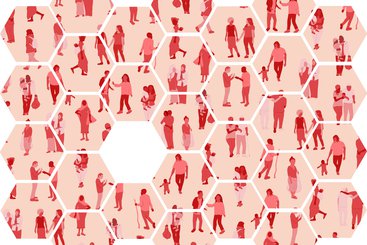Social cohesion is often seen as a force for good – as a necessary foundation for development, growth, peacebuilding and conflict resolution.
Societies with high levels of trust and cooperation have been found to have stronger economic performance, in part because these conditions reduce the risks and costs of doing business together. Cohesion is especially important for people affected by displacement, because social connections are the conduits through which they receive support, both material and non-material, such as cash, food, information and advice. Cohesion can also strengthen security in refugee-hosting communities, and has thus been integrated into the peacebuilding frameworks of various organisations including the United Nations Development Programme (UNDP), International Organization for Migration (IOM) and the UN Children’s Fund (UNICEF).
While the benefits of social cohesion are clear, our research from Kenya, Tanzania and Lebanon illustrates how power asymmetries between refugees and hosts can obfuscate aspects of intercommunal relations that at first seem straightforward. These complications highlight some of the risks and limitations of interventions intended to promote social cohesion in contexts of protracted displacement.
Refugee–host relations are more complicated than they look
One problem with social cohesion is that those who are looking for it may be tempted to see it everywhere. In one survey administered at the Kakuma refugee camp in Kenya, refugees were asked whether they had ‘shared a meal’ with anyone from the local host population. Initially, it was assumed that affirmative responses would indicate friendly relations across the refugee–host divide. But later qualitative research dashed this assumption, revealing that many refugees – who lacked cash – were using prepared food as a form of payment to purchase firewood from local Kenyan women.
What seemed like evidence of hospitality was actually a transactional interaction shaped by unequal access to local resources: refugees in Kakuma were not allowed to cut their own firewood, and could face violence if they wandered outside their designated area in search of it. The only way they could acquire cooking fuel was by purchasing it from local Kenyans, who accepted a mix of cooked and uncooked food as payment.
Refugee–host relations are similarly complicated in Tanzania’s camps. At first sight, instances of cooperation between refugees and nationals provide an encouraging example of what social cohesion can offer. For example, because they do not possess a national ID, refugees in Tanzania are not allowed to register for a SIM card, purchase property, open a bank account, request a bank loan, establish a business, or access government subsidies. They therefore turn to Tanzanian friends, acquaintances and neighbours to register on their behalf.
While such arrangements can be described as cooperation, they also reflect an imbalance of power, as refugees are forced to rely on Tanzanians to access basic services and register their businesses. It is not necessarily that refugees choose to cooperate with friends in the host population (although some do), many don’t have another option. And if a disagreement arises, they may fear falling out with Tanzanians upon whom they rely. This was summed up by an elderly Burundian refugee: ‘I have to get along well with them because I need their help.’ When asked whether he still thinks it’s important to get along, even when a Tanzanian has done something to upset him, he replied: ‘Yes, because he helps me.’ Some refugees describe a depressing sense of resignation: that they must accept their situation without complaint and be grateful for their lot or risk jeopardising their already precarious situation.
These examples show that there is often more to community relations than meets the eye. In contexts where national policies restrict refugees’ rights and movements, their relations with hosts are structured by an inherent inequality that puts refugees at a disadvantage, regardless of how friendly, familiar or cooperative they are. Under these circumstances, ‘cohesion’ among refugees and hosts can be a euphemism for less congenial arrangements that are necessitated by a lack of other options.
Unintended consequences of promoting social cohesion
When programmes and policies to promote social cohesion don’t recognise these inequalities and complications, they risk producing unintended consequences for relations between refugees and their host communities.
For example, it is now widely understood that social tensions and conflict emerge when aid is distributed to one group but not others, such as refugee aid that is not provided to people in the host population. This can be especially contentious where poverty levels among the host population are high, such that they face similar levels of food insecurity and economic precarity as refugees. One strategy for maintaining cohesion in displacement-affected contexts has been to ensure that aid distribution is fair and inclusive.
In Lebanon, which has hosted over 1 million displaced Syrians over the past decade, an ongoing economic crisis that began in 2019 has wiped out the assets of many Lebanese households. The rising poverty level among nationals has pushed organisations previously focused only on refugee assistance to include Lebanese as beneficiaries, in the hopes of reducing tension over aid distribution.
However, such strategies can sometimes hurt more than they help. One study of a shelter rehabilitation project in eastern Lebanon found that distributing benefits to displaced Syrians and local residents had actually disrupted their relationship, shifting it from one of hospitality to something more transactional. One elderly man complained that, before the intervention, Lebanese residents had been largely sympathetic to the plight of their new neighbours. While there was tension, there was also understanding. But the arrival of the new programme had changed the perception of Lebanese landlords. They began to treat their Syrian tenants not as a displaced population in need of support, but as a means of acquiring resources from non-governmental organisations (NGOs), including the funding provided for shelter rehabilitation.
Promoting cohesion can also be complicated in contexts of where refugee–host relations are tense. At the Kakuma camp in northwestern Kenya, a long history of marginalisation among the local host population has given rise to grievances about the refugee-centric distribution of aid. In an effort to prevent conflict and maintain peaceful coexistence, humanitarian actors have extended some of the ‘benefits’ of aid to the local population. The self-reliance agenda yielded a particularly large windfall for some local business owners, who were included along with refugee entrepreneurs as registered retailers under an electronic food voucher programme. While some local Kenyans have certainly benefited, these efforts have not necessarily reduced tensions. For one, narratives about extending benefits to the ‘host community’ reinforce identification with the ‘refugee’ and ‘host’ labels, which are ultimately divisive. Moreover, calls for further entitlements for the host community have at times been politicised, with local elites claiming to speak on behalf of the entire host population while advocating for the interests of one group.
Grievances about the distribution of aid can also cause tensions between different groups of refugees – not just between refugees and hosts. In Tanzania, protests and violence erupted in Nyarugusu camp when bars of soap were distributed only to Burundians and not to Congolese refugees – allegedly because the donor wanted to ringfence this group for assistance. The subsequent abandonment of the controversial project further aggravated tensions among Burundians who blamed the Congolese for frustrating their opportunity to receive the soap. Tensions resulting from aid went beyond national rivalries. Some refugees in Tanzania also complained that women, children, people with disabilities and the elderly were prioritised for assistance over the general refugee population. The restriction of firewood distribution to vulnerable groups and the elderly was especially controversial.
A key issue was that refugees did not understand or agree with why vulnerable groups were prioritised in the first place. Most felt that their views were not adequately taken into consideration by aid actors, or that efforts to engage were tokenistic. The risk of social tensions could have been reduced through effective communication of the selection criteria, and better involvement of refugees in decision-making about the project rationale.
To sum up, social cohesion comes with its own risks, which are not well understood or widely recognised within aid circles. With this in mind, aid actors should adopt more critical approaches to social cohesion. There is an argument for ‘doing social cohesion better’. But there is also a case for ‘doing social cohesion less’ – specifically in places where social cohesion isn’t the priority, or worse still, where programming puts people in danger or makes social tension worse.
Rodgers’s research was supported by the AHRC-FCDO Collaborative Humanitarian Protection Research Programme [Grant No. AH/ T007443/1], with funding from the Arts & Humanities Research Council and the Foreign, Commonwealth & Development Office.
Suggested reading list
Betts, A., Stierna, M.F., Omata, N. and Sterck O. (2021) Social cohesion and refugee–host interactions: evidence from East Africa. Policy Research Working Paper. Washington DC: World Bank.
King, E., Samii, C. and Snilstveit, B. (2010) ‘Interventions to promote social cohesion in sub-Saharan Africa’ Journal of Development Effectiveness 2(3): 336–370.
Knack, S. and Keefer, P. (1997) ‘Does social capital have an economic payoff? A cross-country investigation’ Quarterly Journal of Economics 112(4): 1251–88.
Rodgers, C. (2021) ‘The “host” label: forming and transforming a community identity at the Kakuma Refugee Camp’ Journal of Refugee Studies 34(2): 1859–1878.
Stites, E. and Humphrey, A. (2020) The currency of connections: the role of social connectedness among South Sudanese Refugees in West Nile, Uganda. Washington DC: Mercy Corps.
Sturridge, C., Kamanga, K.C., Ruhundwa, J., et al. (2023) ‘What aid actors need to know about social cohesion in displacement’. HPG case study. London: ODI.




